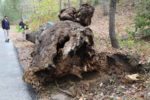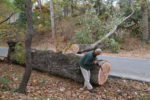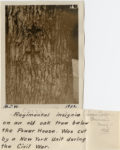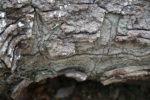 A white oak at Mount Vernon that was a witness to history from the time of George Washington has fallen. The oak was 115 feet tall and 12 feet in diameter and was at least 240 years old when it fell down across a road through the woods on the night of November 4th. There was no storm, not even any wind. The tree wasn’t rotten, damaged or diseased. It was the oak equivalent of dying peacefully in its sleep.
A white oak at Mount Vernon that was a witness to history from the time of George Washington has fallen. The oak was 115 feet tall and 12 feet in diameter and was at least 240 years old when it fell down across a road through the woods on the night of November 4th. There was no storm, not even any wind. The tree wasn’t rotten, damaged or diseased. It was the oak equivalent of dying peacefully in its sleep.
 Dean Norton, Mount Vernon’s director of horticulture, counted the rings from the cut trunk and conservatively dated the oak to at least 1780. It might be even older. (Some of the rings blend into each other and can’t be precisely counted.)
Dean Norton, Mount Vernon’s director of horticulture, counted the rings from the cut trunk and conservatively dated the oak to at least 1780. It might be even older. (Some of the rings blend into each other and can’t be precisely counted.)
Norton said there is also a possibility that Washington had purposely transplanted the tree from the local woods. It had stood in what looked like a man-made triangle of three trees, all the same age, all the same kind, and never cut down.
“To me, they were intentionally, not only planted, but saved,” he said.
The other two are already gone. The first fell about 40 years ago; the second in August of last year. The three were near a road about a half-mile west of the mansion, Norton said.
 Mount Vernon was treated as neutral ground during the Civil War, but all three of these oaks were informally enlisted on the Union side. A star and a cross, insignia of two Union Army corps, were carved into the bark of the three oaks in 1865. The five-pointed star and Latin cross can still be seen on the fallen trunk, albeit less distinctly. An archival photograph from 1932 shows them more distinctly, and a curatorial note attributes them to a New York regiment that visited Mount Vernon while it was in Washington, D.C. for the Grand Review of the Armies in May 1865. This was the last tree still standing at Mount Vernon with Civil War carvings in its bark.
Mount Vernon was treated as neutral ground during the Civil War, but all three of these oaks were informally enlisted on the Union side. A star and a cross, insignia of two Union Army corps, were carved into the bark of the three oaks in 1865. The five-pointed star and Latin cross can still be seen on the fallen trunk, albeit less distinctly. An archival photograph from 1932 shows them more distinctly, and a curatorial note attributes them to a New York regiment that visited Mount Vernon while it was in Washington, D.C. for the Grand Review of the Armies in May 1865. This was the last tree still standing at Mount Vernon with Civil War carvings in its bark.
 Mount Vernon was a mecca for soldiers on both sides of the Civil War. George Washington was a revered native son of Virginia as well as the first President of the United States, so Union and Confederate soldiers alike had reason to pay their respects. It was an immensely popular attraction for Union troops in particular. An estimated 200 Federal regiments visited Mount Vernon from 1861 to 1865.
Mount Vernon was a mecca for soldiers on both sides of the Civil War. George Washington was a revered native son of Virginia as well as the first President of the United States, so Union and Confederate soldiers alike had reason to pay their respects. It was an immensely popular attraction for Union troops in particular. An estimated 200 Federal regiments visited Mount Vernon from 1861 to 1865.
The Mount Vernon Ladies’ Association, which had acquired the dangerously dilapidated mansion and 200 acres of the property from John Augustine Washington III in 1858 and taken possession in 1860, had members from north and south and consciously eschewed all partisanship. Their sole goal was to repair the estate, which was literally falling apart and propped up by repurposed ships’ masts, and honor Washington’s legacy. When Civil War broke out and Virginia seceded from the Union in the spring of 1861, MVLA regent Ann Pamela Cunningham declared that Mount Vernon should be neutral territory, that any troops, Union or Confederate, who visited should not be armed or uniformed.
Her wishes were conveyed to all soldiers in the area and respected to the best of their abilities. In a May 2nd, 1861 letter to Cunningham, her secretary Sarah Tracy reported:
[The troops] have behaved very well about it. Many of them come from a great distance and have never been here, and have no clothes but their uniforms. They borrow shawls and cover up their buttons and leave their arms outside the enclosures, and never come but two or three at a time. That is as much as can be asked of them.”
Union General Winfield Scott made it a formal policy that Mount Vernon was to be left alone in General Order 13, issued on July 31, 1861:
Should the operations of our war take the United States troops in that direction, the General Officer does not doubt that every man will approach with due reverence, and leave undisturbed, not only the Tomb, but also the house, groves and walks which were so loved by the best and greatest of men.
The fallen oak will remain at Mount Vernon, indeed will become even more a part of it as it will be used by the preservation department to make necessary repairs.
The photos support a twelve-foot circumference, not a twelve-foot diameter.
The bole should be radially-sawn and used, at least in part, as a fund-raiser, with small slabs laser-carved with the star and cross.
A traveller on a dusty road
Strewed acorns on the lea;
And one took root and sprouted up,
And grew into a tree.
Love sought its shade at evening-time,
To breathe its early vows;
And Age was pleased, in heights of noon,
To bask beneath its boughs.
The dormouse loved its dangling twigs,
The birds sweet music bore—
It stood a glory in its place,
A blessing evermore.
–Charles Mackay
I am saving this to go with my genealogy on Anne Fairfax Washington Lee, my 6th Great Grandmother who owned Mount Vernon before President Washington did, and who lived there with him when he was a teen, along with his half-brother Lawrence. After Lawrence’s death and Anne’s remarriage to George Lee and their move to her mother’s home in Barbados, she RENTED Mt. Vernon to George Washington, and ownership of it reverted to him after she died.(as per his and Lawrence Washington’s father’s will.) 😀
Just 240 years of age for an oak does not seem an awful lot. I am not an expert here, but that trunk does not seem to be really old and basically in good shape.
Not at all in good shape, unfortunately, seems to be the tree’s base in the 1st picture, almost as if something had eaten away at it’s roots. Thus, I wonder what actually has happened. To begin with, what about the soil?
:ohnoes:
I am surprised, given the interest in the tree’s origins, that they have not done some dendrochronology, the scientific analysis of tree ring patterns and comparison to other examples of the same species in the same region. This provides more detailed and accurate dating than just counting the rings visible to the naked eye.
The Dukh Bhanjani Beri tree on the bank of the Sarovar on Langar hall side, in the Golden Temple complex in the Punjabi city of Amritsar in India, is said to be of the 16th Century. The tree is over 400 years old. The local Sikh community pays attention to the health of that historic tree.The much younger and only 240-year-old oak at Mount Vernon should have been saved from falling.